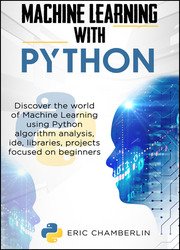 Название: Machine Learning Using Python: Discover the world of Machine Learning using Python algorithm analysis, IDE and libraries. Projects focused on beginners Название: Machine Learning Using Python: Discover the world of Machine Learning using Python algorithm analysis, IDE and libraries. Projects focused on beginners
Автор: Eric Chamberlin
Издательство: Amazon.com Services LLC
Год: 2020
Страниц: 132
Язык: английский
Формат: pdf, azw3, epub
Размер: 10.1 MB
Are you one of those individuals who want to learn more about Machine Learning using Python? Perhaps you are seeking a detailed guide explaining how you can manage Machine Learning easily and hassle-free. Then look no further because this book got you covered! The word Machine Learning (ML) is all about the ability of a machine to learn and acquire something without any pre-existing program. Did you know that automatic learning is a means to educate an algorithm to learn from different environmental scenarios?
Machine learning is all about the use of massive volumes of data, and an effective algorithm enabled us to improve and adapt its abilities based on recurring circumstances. Humans utilize machine learning data algorithms to make their experience more secure, simpler, and efficient from online shopping to social media and banking operations.
Python will always be the choice of programmers because of its high rate in enhancing productivity. The steps in Python are edit, test and debug, respectively. Interestingly, a mistake in the code input of Python will never result in segmentation with a fault; this has made many programmers resort to the fact that it is one of the easiest languages for debugging. Instead of creating through the interpreter a segmentation with fault, python would rather develop a form of exception. If this exception is not still captured, it will be printed as a stacked race –just to keep everything safe.
You can confidently say that any change made to the structure of the machine, the data composition, or the data stored in the machine to improve the performance and accuracy of a machine is a sign of learning. When you try to better understand the concept of Machine Learning, you will realize that only some of these changes can be categorized as Machine Learning.
Scikit-learn has been in use as a Machine Learning library inside of Python. It is going to come with numerous classifications, regression, and clustering to help you get more results. Some of the algorithms that you will get to use with this system is going to include DBSCAN, k-means, random forests, support vector machines, and gradient boosting, to name a few. And Scikit-learn was designed so that it would work well with some of the other popular libraries found on the Python code, including with SciPy and Numpy libraries.
This book aims to offer you all the details you need to leverage your skills and offer you the right level of education. All the topics included in this guide will be supported by practical exercises and examples, which will allow you to reinforce your level of knowledge.
This book has been written to meet every level of education. There’s no need for you to worry if your level of knowledge is low and doesn’t have any prior experience. Let this book be your ultimate guide.
Contents:
CHAPTER 1: Machine Learning History
CHAPTER 2: What is Machine Learning?
CHAPTER 3: Categories of Machine Learning
CHAPTER 4: Sectors and Industries that use M.L
CHAPTER 5: Introduction to Programming Languages
CHAPTER 6: Why Python
CHAPTER 7: Installing Scikit -Learn
CHAPTER 8: IDE (Spyder, Jupiter)
CHAPTER 9: Introduction to the Main Python Libraries
CHAPTER 10: Introduction to Bias and Variance
CHAPTER 11: Evaluating the error in the Regression models (RMSE, MAE, R2)
CHAPTER 12: Supervised Learning
CHAPTER 13: Linear Regression
CHAPTER 14: Random Forests -Theory
CHAPTER 15: Evaluation Metrics and Classification Models
CHAPTER 16: Unsupervised Learning
CHAPTER 17: Deep learning
CHAPTER 18: Logistic Regression-Theory
CHAPTER 19: KNN -theory
CHAPTER 20: Support Vector Machines Classification
CHAPTER 21: Reinforcement Machine Learning Algorithms
CHAPTER 22: Naive Bayes -Theory
CHAPTER 23: Decision Trees -Theory
CHAPTER 24: Benefits of Machine Learning
CHAPTER 25: Deep Neutral Network
CHAPTER 26: Big Data Analytics
CHAPTER 27: Data Mining and Applications
Conclusion
Скачать Machine Learning Using Python: Discover the world of Machine Learning using Python algorithm analysis, IDE and libraries. Projects focused on beginners
|